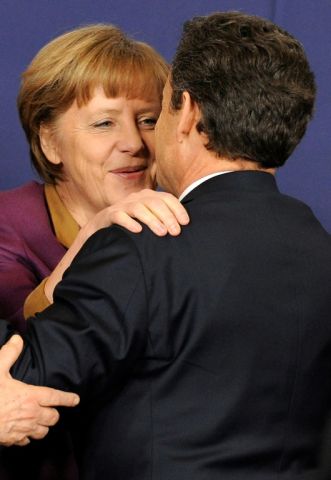Franco-German power couple, a driving force

France and Germany have produced some of the world's most influential power couples since signing a treaty setting their friendship in stone in the wake of World War II.
The two countries have since been the driving force in European integration.
- 1958-1963: De Gaulle, Adenauer -
In 1962 Charles de Gaulle becomes the first French head of state to visit the Rhineland since Napoleon and receives an enthusiastic welcome from thousands of Germans.
Several months later he signs the Elysee Treaty with West Germany's conservative chancellor Konrad Adenauer, cementing friendship after years of conflict.
Their bond of trust foresees what becomes known as the Franco-German "axis" or "couple", which goes on to drive European construction.
- 1969-1974: Pompidou, Brandt -
Georges Pompidou and Willy Brandt, who come to power in 1969, relaunch economic cooperation, agreeing to jointly build the Airbus airplane and the Symphonie telecommunications satellite.
The conservative Pompidou and the Social Democrat Brandt do not have a lot in common but still manage to hold dialogue.

- 1974-1981: Giscard, Schmidt -
Elected almost at the same time in 1974, the Social Democrat Helmut Schmidt and centre-right president Valery Giscard d'Estaing inject a new impetus into European integration.
Under their steam, regular European summits are held and they lay down the basis for monetary union in Europe, with the 1978 establishment of the European Monetary System (EMS).
- 1982-1995: Mitterrand, Kohl -
In a highly symbolic gesture, the Christian Democrat Helmut Kohl and the socialist Francois Mitterrand hold hands in 1984 at Verdun, the scene of the worst battle of World War I.
The two men are very different, but share a common sense of history. They propel Europe forward with, in 1986, the Single European Act, which creates a single market among the European bloc's members.
After being initially wary of German reunification led by Kohl after the fall of the Berlin Wall, Mitterrand's support opens the way to the creation of a single European currency and enhanced diplomatic and military cooperation.
- 1998-2005: Chirac, Schroeder -
The Social Democrat Gerhard Schroeder and conservative Jacques Chirac get off to a stormy start, despite the birth of the European Union's euro single currency.
But relations then improve and they meet regularly. From 2002 the couple launch themselves into plans for a European constitution and work to make Europe a political bloc.
In 2003, their common opposition to the US-led invasion of Iraq brings them closer still.
But the negative result of France's referendum on the European constitution in 2005 causes strains in the relationship.

- 2007-2012: Sarkozy, Merkel -
They might both be on the centre right, but Nicolas Sarkozy and Angela Merkel have a difficult start.
However, from 2009 the couple take centre stage during the eurozone debt crisis, when, despite disagreements and declarations, on the one hand, of love, and irritation on the other, the "Merkozy" couple engineer an EU fund to help debt-stricken nations and propose a budgetary pact to rein in public debt.
- 2012-2017: Hollande, Merkel -
Merkel and Socialist President Francois Hollande stand shoulder to shoulder after the deadly jihadist attacks in Paris in early 2015 and together secure a Ukraine peace plan in Minsk, Belarus in February the same year.
- From 2017: Macron, Merkel -
President Emmanuel Macron and Merkel use a series of war anniversaries to project unity as they push back against populist and nationalist forces in Europe and Donald Trump's isolationist "America First" stance.
However, with both leaders politically weakened at home, the traditional driving power of the Franco-German couple at the heart of the bloc is reduced.
Macron meanwhile seeks stronger backing from Merkel on a range of reforms to strengthen Europe.
